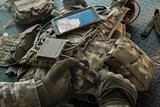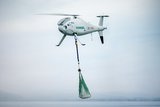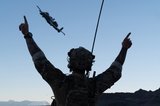Just released: Night Vision & Situational Awareness Technology Report 2024 now available to read
In Shephard’s new Technology Report, Gerrard Cowan explores how the latest night vision systems can do so much more than ‘see in the dark’ and the way they can interact with other dismounted devices to create a comprehensive picture of the battlefield.
In Part 1 Gerrard tackles the current and future potential of night vision devices, examining new use cases and augmentations for what is now a mature technology, including sensor fusion, display overlays and fresh approaches to the perennial SWAP challenge of providing portable capabilities effectively and reliably.
Colonel (P) Phil Kiniery, director of the Soldier Lethality Cross Functional Team within US Army Futures Command, told Shephard that recently developed night vision frameworks include fully digital options, for example, with fused sensors that accept external feeds, sometimes offering the capacity to exchange information across the network.
‘Current efforts that incorporate small UAS allow soldiers to better understand their environment without putting them in harm’s way,’ he added. ‘Now they can capture the kind of information or intelligence they once would have had to pursue on foot.’
Integration of sensors with legacy enablers will form new systems that enable squad-level situational awareness, he said, instead of just at individual level, ‘thereby functioning as part of a larger enterprise while reducing the burden across the unit.’
Part 2 takes a wide view of soldier-worn sensor systems, assessing how developers can capitalise on the variety of digital devices now available to enhance lethality and survivability and create a truly battlespace-wide network, while addressing concerns such as data security and cognitive overload.
Matthew Renzi, senior director of engineering at L3Harris, said there were four major focuses when it comes to integrating soldiers into a wider battlespace picture. First is the information that is being generated; then there is the ability to process that information locally on the warfighter’s person; third is the ability to display the information; and finally there is the ability of the warfighter themselves to take action on the data.
‘Once you have that system in place, it really becomes a question of how to utilise it to gain the best information that is required for decision-making,’ Renzi said. ‘That becomes a bigger challenge, but having the display and the processing capability really is key to the whole system. It’s all about getting the right information at the right time, to the right person, helping that decision-making and reducing the cognitive overload that may occur.’
More from Technology Reports
-
![Just Released: New UAS Technology Report now available to read]()
Just Released: New UAS Technology Report now available to read
Autonomous advantage: Unlocking the potential of VTOL UAS in the battlefield resupply role
-
![Just Released: Military Training Technology Report December 2024 now available to read]()
Just Released: Military Training Technology Report December 2024 now available to read
In this latest Shephard technology report, Giles Ebbutt highlights the rise of the first person view (FPV) drone as a powerful asymmetric weapon that can …
-
![Just Released: Military Training Technology Report October 2024 now available to read]()
Just Released: Military Training Technology Report October 2024 now available to read
How the latest portable simulation solutions can deliver JTAC training wherever it is needed
-
![Just Released: Space Technology Report]()
Just Released: Space Technology Report
Why space is an essential part of modern military capabilities
-
![The imperative for a vibrant UK space industry]()
The imperative for a vibrant UK space industry
Ahead of a new Shephard Technology Report to be published in September, senior executives from Lockheed Martin Space have underlined the importance of investing in defence space systems by countries like the UK.
-
![Just released: Military Training Technology Report 2024 now available to read]()
Just released: Military Training Technology Report 2024 now available to read
How cutting-edge technologies are combining to produce ultra-realistic simulation.


























